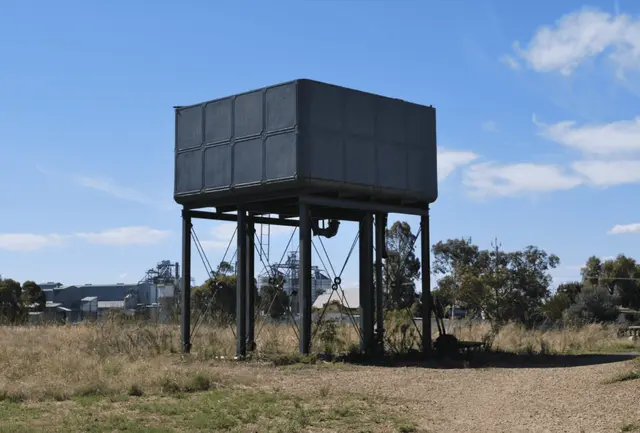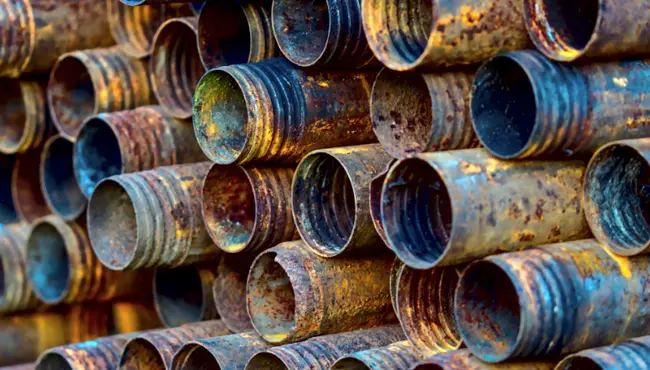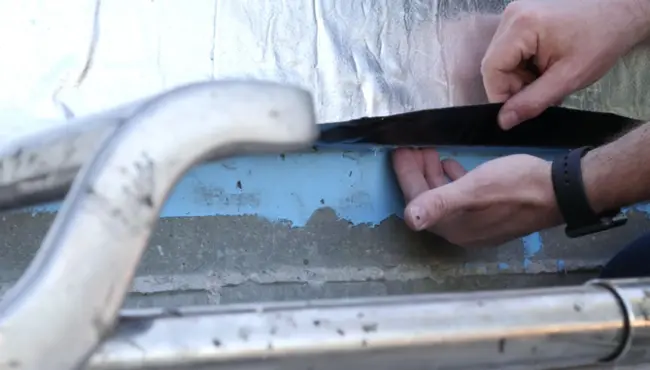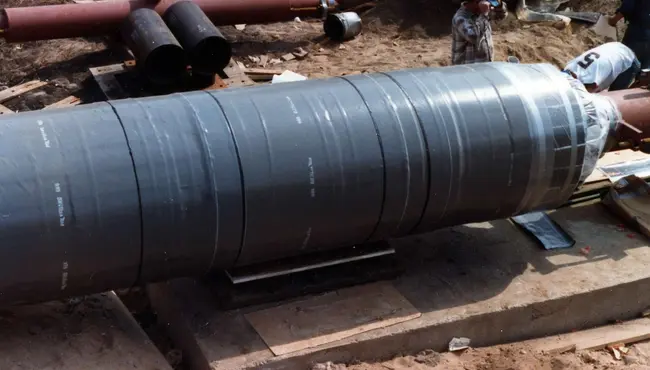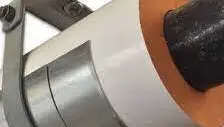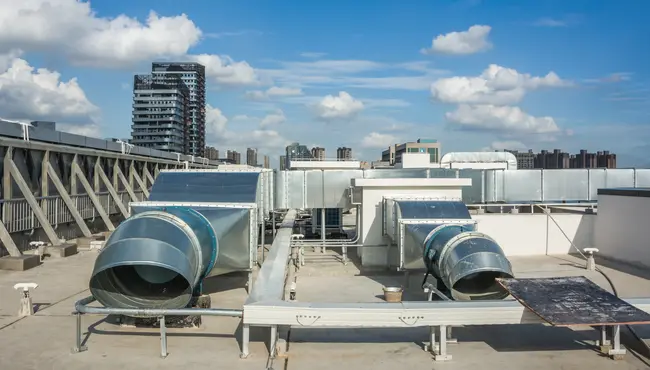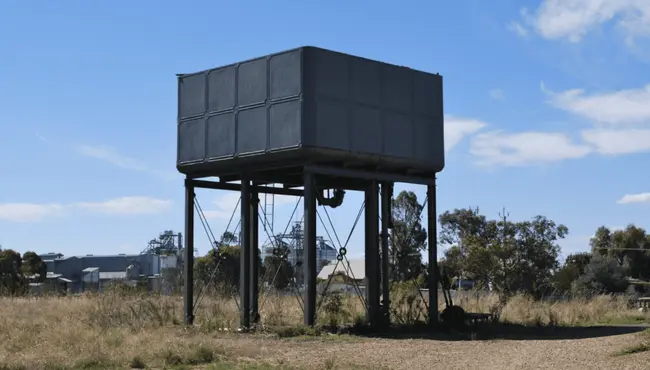In cold climates, commercial and residential outdoor water tanks need tank insulation to protect against freezing, which can damage the tank and plumbing, and compromise the safety of the water supply. Other methods for protecting outdoor water tanks from freezing include submersible electric water heaters, electric heating blankets, and external heating systems. However, thermal insulation does not require energy or maintenance after installation, and provides a cost-effective way to protect an outdoor water tank from cold temperatures.

Image Credit: Wikimedia.org
Why Apply Storage Tank Insulation?
Applying insulation to an outdoor water storage tank will ensure a year-round steady water supply for drinking, cleaning, and many other uses. In addition, water delivery can be streamlined for many commercial applications, including commercial food and beverage preparation, agricultural and irrigation, fire suppression, and industrial manufacturing. Many families find home water tanks very useful. Long-term water storage saves money on water bills, maintains the family’s standard of living during water restrictions, contributes to conserving natural resources, and provides water for irrigating a home garden.
Protecting Outdoor Water Tanks from Extreme Temperatures
Extreme cold temperatures compromise the integrity of water storage tanks and plumbing because water expands as it freezes. If the water tank freezes, it can take a long time to thaw, particularly in winter. Therefore, you must winterize the tank before the first frost, with outdoor tank insulation, or submersible electric water heater, electric heating blankets, or an external heating system in order to keep your winter water supply safe.
Outdoor Water Tank Insulation
Wrapping a water tank with insulation will significantly limit the risk of freezing; however, the amount and type of insulation that should be used depends on the climate. Colder temperatures require more protective and robust insulation. In addition, you should insulate any pipes running to or from the tank since these will freeze much faster than the water tank.
The 2021 International Energy Conservation Code (IECC C403.12.3) mandates insulation for piping associated with cooling and heating that carries fluid with an operating temperature of 105 °F or more, or 60 °F or less. Furthermore, you must protect the insulated water tank and piping from exposure to moisture, sunlight, and wind, in order to prevent damaging the insulation’s effectiveness.
Polyguard has all the products you need to protect and insulate your outdoor water storage tank and piping: ReactiveGel RG-2400®, PolyPhen® Phenolic Insulation, and Alumaguard®.
ReactiveGel RG-2400 stops corrosion under the insulation (CUI) for metal outdoor water tanks.
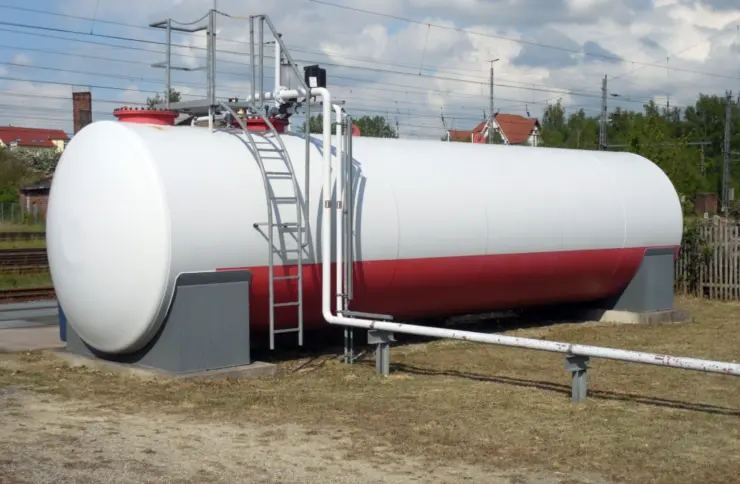
ReactiveGel RG-2400 (Blue Goo) applies to a clean, rust and debris-free water tank and piping until you no longer see the metal. For large tanks, you can directly spray the RG-2400. For large pipes, polyguard also recommends installing our mesh fabric before applying the insulation and vapor barrier.
Polyguard RG-2400 offers a series of products to stop CUI for water tanks, meeting the specific needs of your commercial or residential metal outdoor water tank:
- RG-2400 LT – for systems up to 250º F (121º C).
- RG-2400 ET – for 350° F (177° C) operating temperatures, crucial for steam lines with temperature cycles ranging from ambient to hot.
- RG-2400 AK – stops stainless steel and copper stress crack CUI, used on in-service HOT Line applications up to 250º F (121º C).
- RG-2400 NP – anti-corrosion gel is applied to new piping systems up to 230º F.
- RG-CHW – offers a solution for CUI on chilled water systems with 40º F – 140º F temperature ranges.
PolyPhen Phenolic Insulation prevents heat loss to your outdoor water tank.
PolyPhen® Phenolic insulation installs over the RG-2400, to efficiently stop the flow of heat and vapor to and from the water tank and pipes. Computerized cutting-technology by specialist fabricators improves the insulation system’s value by providing a consistent tight-fit.
Eco-friendly, flame-resistant, closed-cell Polyguard PolyPhen® offers a range of rigid foam insulation densities designed for commercial, industrial, and residential applications like water tanks and piping. With thermal conductivities between 0.17 – 0.24 Btu in/(hr ft2), you can apply PolyPhen® closed-cell insulation to insulate surfaces in the temperature range of -290° F to +250° F (-180° C to +120° C). The insulation thickness varies depending on the water tank and piping temperature.
Why Choose Phenolic Insulation?
Phenolic materials are a reaction from mixing phenolic resin mix solids and a surface-acting agent to create a network of bubbles that is cured into a closed-cell foam, to enhance its thermal and moisture resistance over open-cell foam.
Phenolic insulation’s low thermal conductivity gives it double the insulating capabilities of other insulating products like fibrous glass (open cell), cellular glass (partially closed cell), and elastomeric (closed cell).
The high R-value and low thermal conductivity save money because it needs less insulation to maintain the same performance as other materials.
Furthermore, fire-resistant phenolic insulation achieves an ASTM E84 25/50 Class A flame and smoke rating. In addition, many phenolic foams do not burn at all when exposed to an E84 flame test, yielding a perfect 0/0 rating.
Environmentally-friendly phenolic insulation produces low levels of toxic gas emissions. Old insulation can also be remanufactured into a new product.
Alumaguard and Alumaguard Cool Wrap controls moisture infiltration
Flexible, energy-saving Polyguard’s zero perms Alumaguard® weather-proofing cladding stops damaging air, moisture, and vapor intrusions to water tanks and piping insulation.
Submersible Electric Water Heater
A submersible electric water heater can prevent your tanks from freezing by delivering a current from a heating element to a conductive substance, like steel, which heats the water, and prevents ice formation. Extremely cold areas may require a combination of submerged heaters and insulation.
Electric Heating Blankets Wrap
Electric heating blankets wrap around the tank like a jacket, and generate heat from an electrical source, to provide temperature controls in response to weather conditions. Electric heating blankets cost more and require additional upkeep than insulation material but provide an effective way to prevent your tank from freezing.
Exterior Heating Systems for Large Tanks
Large water tanks at high risk of freezing may require heating systems on the tank’s exterior. These costly, complicated, and large systems use a lot of energy but are necessary for extreme situations.
Tips for Minimizing the Risk of Freezing
Besides the use of insulation and electric heating systems, you can minimize the risk of your tank freezing by following these helpful tips;
- Purchase a large tank since it will freeze slower than a smaller tank.
- Select a round tank since a smaller surface size insulates more effectively than a similar square or rectangular tank.
- Inspect and repair all cracks and leaks in the tank and network of pipes since the defects will increase heat loss and quicken the freezing process.
- Place the tank underground for more stable and consistent temperatures.
- Choose cheaper plastic tanks because they can withstand the force of expansion due to freezing better than a metal tank.
- Keep the water running with a plumbing system or pressurized water line, anything to keep the water moving.
Insulating an Outdoor Water Tank with Polyguard Products
Polyguard products provide a superior solution to insulating and protecting your outdoor water tank against freezing, to ensure a constant and safe water supply. PolyPhen® Phenolic Insulation, combined with ReactiveGel RG-2400®, and Alumaguard® will guarantee your outdoor water tank’s long-term integrity and performance, and protect against freezing conditions, corrosion, and vapor and air intrusion.
For more on how to insulate an outdoor water tank, don’t hesitate to contact the professionals at Polyguard today.
